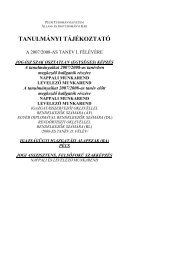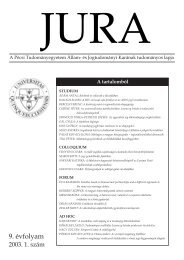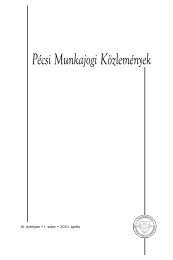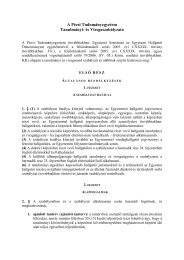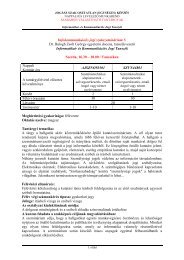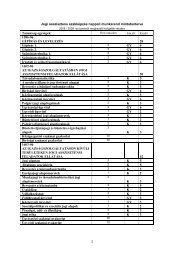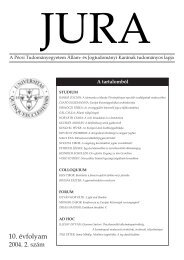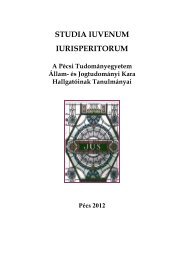2012. évi 2. szám - Jura - Pécsi Tudományegyetem
2012. évi 2. szám - Jura - Pécsi Tudományegyetem
2012. évi 2. szám - Jura - Pécsi Tudományegyetem
- TAGS
- jura
Create successful ePaper yourself
Turn your PDF publications into a flip-book with our unique Google optimized e-Paper software.
Helen Xanthaki: The UK Human Rights Act: a true excuse for judicial lawmaking by the aw Lords?245or at least comes as a direct or indirect consequenceof, the alleged increased liberties offered to UK judgesvia the HRA 1998. I find it difficult to support theview that it is the HRA which changed the approachof UK judges to a more activist approach of interpretationcontributing to a tolerance of judge made lawin the general sphere of human rights. Although anempirical analysis of each of the judgements producedin application of s.3 HRA would have madean eloquent argument either way 7 , this seems to meto be outside the scope of an essay of this length.And so one can only resort to qualitative analysis. Itis interesting to note that purposive interpretationcame about in 1993, about 5 years post the passingof the HRA: and so time-wise one could suggest thatthe moment was opportune. But although purposiveinterpretation may be attributed in part to the newjudicial liberties resulting from the power to declareActs incompatible by use of the HRA, purposiveinterpretation does not depart from the UK traditionof statutory interpretation as much as some UKcommon lawyers suggest. Judges still have to, andlargely do, comply with the limits set to them by thelimited necessity of statutory interpretation, and bypresumptions and maxims that delimit their allegedtendency to judicial activism, and set clear guidelinesas to how statutory interpretation must take placeirrespective of what rule is to be used. 8b) Limits for judges post 1998There are limits and restrictions inherent in the UKsystem of statutory interpretation whose legal valueand consequent application in practice remains unaffectedand continues to qualify all rules of statutoryinterpretation, including purposive interpretation. 9Firstly, interpretation is only invited when themeaning of words is unclear or disputed. So purposiveinterpretation is not needed and therefore notinvited or tolerated for the purposes of everydayconstruction and application of the law. Interpretationis therefore limited to the extraordinary, albeitfrequent, cases where there are either problems ofdrafting arising from the words of the statute alone,before any set of facts has been presented for its application;or problems of uncertain application arisingin the process of applying the words of a statuteto a set of facts.Secondly, even under these exceptional circumstancesjudges can only use interpretation for thepurposes of clarifying ambiguous legislation; andsupplementing the legal provisions in cases of acasus omissus. But in both these circumstances ofpossible judicial creativity the legislature have eitherconsciously decided or managed to bring themselvesin the unfortunate position of being silent. And sothe judiciary have legitimacy in their activist role ofthe applicator of the law and the legislator throughcase law.Thirdly, judges continue to be bound by presumptionsand maxims. And so, when using purposiveinterpretation judges continue to work within thelimits of constitutional and legal conventions. As aresult, a latter law continues to repeal an earlier lawthat is inconsistent with the later law. A new lawcontinues to be prospective in character and not retrospectivein operation. Laws continue to be adoptedfor frequent and future cases. A liberal constructioncontinues to be desirable in the interpretation of astatute. A passage continues to be best interpretedby reference to what proceeds and what follows it.The meaning of a doubtful word continues to besought by reference to words attached to it. 10 Therestill is no need to interpret that which has no needof interpretation. The express mention of one thingis still the exclusion of another. Statutes on the samesubject-matter are still to be read together. Generalwords following particular or specific words are stillconstrued as of the same kind or class as the particularor specific words. Perhaps more importantly,there still is a maxim that Parliament legislated for areason. And that one must interpret the laws to giveeffect to the will of the Parliament. 11I think that these three points demonstrate effectivelythat UK judges are not left to use purposiveinterpretation when and as they see fit or opportune.And that although and alleged activism can be attributedto the liberalism of statutory interpretation, atthe end of the day this is well balanced by the checksand balances inherent to the UK constitution.But does that mean that the approach to statutoryinterpretation remains completely unmoved in thelast few years? I believe that the recent approach ofUK judges to statutory interpretation has changedbut not as a direct and sole consequent of the introductionof the HRA. The new liberal approachsimply reflects modern considerations of regionallegal globalisation [with specific reference to the EU’srequirements for teleological judicial interpretation]while maintaining the main UK common law principlesof statutory interpretation.c) Liberties for judges post 1998Can UK judges make law? Does the principle ofprecedent allow UK judges to form legislative precedentthus allowing them to legislate, albeit withinthe limits quoted above? Although UK SupremeCourt judgements are binding on all inferior courts,since 1966 they cannot bind the Court itself. And soJURA 2012/<strong>2.</strong>



